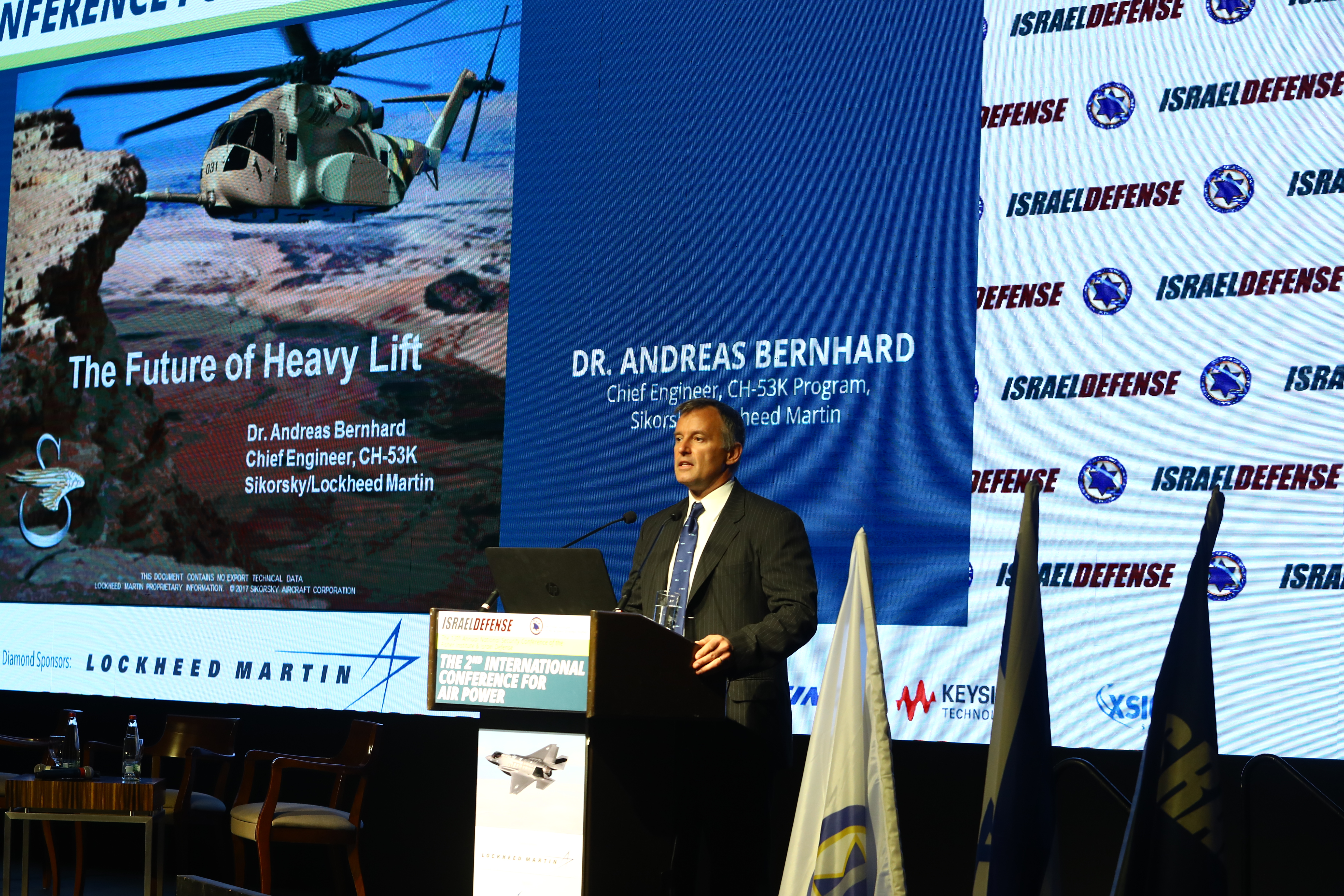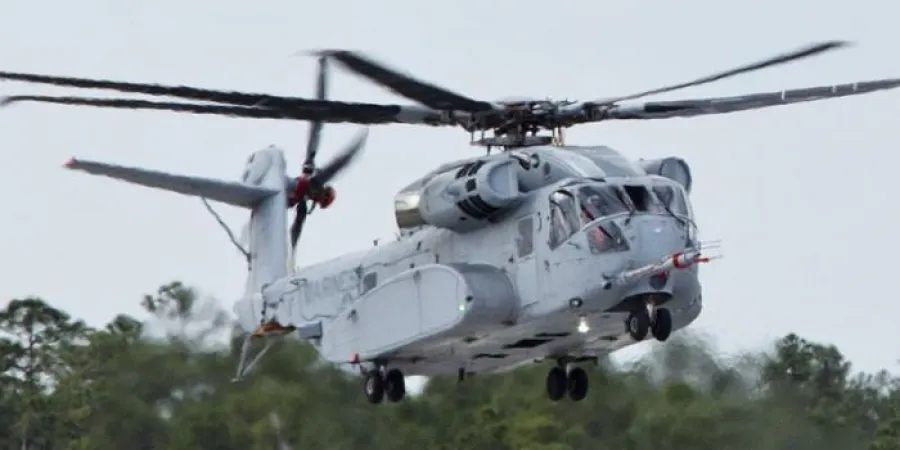Battle over IAF Future Heavy-Lift Helicopter Heats Up
Sikorsky Helicopters/Lockheed Martin held a press conference at the Second International Air Power Conference to announce that they were meeting with IAF representatives regarding the acquisition of the CH-53K heavy-lift helicopter
Dan Arkin
| 04/05/2017
"The Government of Israel has not yet submitted to Sikorsky Helicopters/Lockheed Martin a requisition regarding the CH-53K King Stallion future heavy-lift helicopter, but we are already at the stage of exchanging information, and this week we have already held a meeting on this subject with IAF representatives. We will be delighted to receive a requisition and submit a proposal. We will be proud to provide the IAF with a product like this helicopter," said Dr. Andreas Bernhard, Chief Engineer of the King Stallion helicopter project at Sikorsky Helicopters, a division of Lockheed Martin.
Dr. Bernhard delivered a lecture at the International Air Power Conference produced by Israel Defense and the Fisher Brothers Institute for Strategic Air & Space Studies and held a press conference along with Joshua (Shiki) Shani, CEO of Lockheed Martin Israel. This was an indicator of the imminent competition between the two aviation giants, Sikorsky Helicopters/Lockheed Martin and Boeing, over the future heavy-lift helicopter of IAF that would replace their aging CH-53 (IAF designation Yas'ur) helicopters. Sikorsky Helicopters will offer the new CH-53K King Stallion helicopter while Boeing will offer their CH-47F Block-2 Chinook helicopter – a model that gained extensive combat experience serving with the US military.

Photography: Gilad Kavalerchik
The people of Sikorsky Helicopters/Lockheed Martin stressed their company's 50 years of experience in the development, manufacture, and marketing of heavy-lift helicopters, including the veteran CH-53 Yas'ur helicopters currently in IAF service. Dr. Bernhard stressed, however, that the CH-53K King Stallion is a completely new, highly advanced helicopter. It is capable of speeds of 170 knots "and even more", some of its parts are made of composite materials, it can carry a load of more than 20 tons or 30 fully-equipped warfighters, and that number may be increased. The new King Stallion has three engines and a 7-blade main rotor. Its standard armament consists of two machine guns mounted at the side openings and a third machine gun at the rear. This configuration has already been test-fired. The helicopter is currently under development with test flights and trials already under way, mainly by USMC. 200 helicopters of this type will be manufactured initially. So far, in addition to prospective US clients, Germany has shown interest in the new helicopter and they are currently in the process of preparing their operational requirement documents. The German Air Force operates a Sikorsky heavy-lift helicopter model that is similar to the Yas'ur helicopters in IAF service.
Other features of the King Stallion helicopter positioning it as a completely new model: a glass cockpit with fly-by-wire capability, the option of Infrared and other countermeasures, and the blast-proof crew and passenger seats.
The new CH-53K King Stallion is an expensive helicopter at about US$ 90 million per platform. Responding to the question of the steep price tag, the people of Sikorsky Helicopters/Lockheed Martin said that the helicopter they offer can carry three times as much cargo as the existing helicopters. It can be used for special forces operations, is capable of high speeds and possesses cutting-edge flight characteristics under such difficult conditions as fog or sandstorms. These characteristics enable clients to acquire fewer helicopters for their future missions.
Sikorsky Helicopters/Lockheed Martin held a press conference at the Second International Air Power Conference to announce that they were meeting with IAF representatives regarding the acquisition of the CH-53K heavy-lift helicopter
"The Government of Israel has not yet submitted to Sikorsky Helicopters/Lockheed Martin a requisition regarding the CH-53K King Stallion future heavy-lift helicopter, but we are already at the stage of exchanging information, and this week we have already held a meeting on this subject with IAF representatives. We will be delighted to receive a requisition and submit a proposal. We will be proud to provide the IAF with a product like this helicopter," said Dr. Andreas Bernhard, Chief Engineer of the King Stallion helicopter project at Sikorsky Helicopters, a division of Lockheed Martin.
Dr. Bernhard delivered a lecture at the International Air Power Conference produced by Israel Defense and the Fisher Brothers Institute for Strategic Air & Space Studies and held a press conference along with Joshua (Shiki) Shani, CEO of Lockheed Martin Israel. This was an indicator of the imminent competition between the two aviation giants, Sikorsky Helicopters/Lockheed Martin and Boeing, over the future heavy-lift helicopter of IAF that would replace their aging CH-53 (IAF designation Yas'ur) helicopters. Sikorsky Helicopters will offer the new CH-53K King Stallion helicopter while Boeing will offer their CH-47F Block-2 Chinook helicopter – a model that gained extensive combat experience serving with the US military.
Photography: Gilad Kavalerchik
The people of Sikorsky Helicopters/Lockheed Martin stressed their company's 50 years of experience in the development, manufacture, and marketing of heavy-lift helicopters, including the veteran CH-53 Yas'ur helicopters currently in IAF service. Dr. Bernhard stressed, however, that the CH-53K King Stallion is a completely new, highly advanced helicopter. It is capable of speeds of 170 knots "and even more", some of its parts are made of composite materials, it can carry a load of more than 20 tons or 30 fully-equipped warfighters, and that number may be increased. The new King Stallion has three engines and a 7-blade main rotor. Its standard armament consists of two machine guns mounted at the side openings and a third machine gun at the rear. This configuration has already been test-fired. The helicopter is currently under development with test flights and trials already under way, mainly by USMC. 200 helicopters of this type will be manufactured initially. So far, in addition to prospective US clients, Germany has shown interest in the new helicopter and they are currently in the process of preparing their operational requirement documents. The German Air Force operates a Sikorsky heavy-lift helicopter model that is similar to the Yas'ur helicopters in IAF service.
Other features of the King Stallion helicopter positioning it as a completely new model: a glass cockpit with fly-by-wire capability, the option of Infrared and other countermeasures, and the blast-proof crew and passenger seats.
The new CH-53K King Stallion is an expensive helicopter at about US$ 90 million per platform. Responding to the question of the steep price tag, the people of Sikorsky Helicopters/Lockheed Martin said that the helicopter they offer can carry three times as much cargo as the existing helicopters. It can be used for special forces operations, is capable of high speeds and possesses cutting-edge flight characteristics under such difficult conditions as fog or sandstorms. These characteristics enable clients to acquire fewer helicopters for their future missions.



